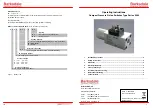
Instructional Booklet
Page
10
Effective: July 2010
ATC-100 Contactor Based Transfer Switch
For more information visit: www.eaton.com
IB01602017E
3.6 Standards
Eaton ATS equipment, enclosed in any of the enclosures listed in
Table 3, is listed for application by UL and ULC. In addition, Eaton
ATSs are listed in File E38116 by Underwriters Laboratories, Inc.
under Standard UL 1008. This standard covers requirements for
automatic transfer switches intended for use in ordinary locations
to provide lighting and power as follows:
a. In emergency systems, in accordance with articles 517
and 700 in the National Electrical Code, ANSI/ NFPA 70,
and the National Fire Protection Association No. 76A; and/
or
b. In standby systems, in accordance with article 702 of the
National Electrical Code; and/or
c. In legally required standby systems in accordance with arti-
cle 701 of the National Electrical Code.
Eaton ATSs are available to meet NFPA 110 for emergency and
standby power systems, and NFPA 99 for health care facilities
when ordered with the appropriate options.
Standard UL 1008 for ATSs lists devices under the reexamination
program which only require a continual physical reexamination of
the components used in the product to ensure consistency with
the originally submitted device. Follow-up testing is not required
by UL 1008.1
Section 4: Installation and Wiring
4.1 General
Eaton ATSs are factory wired and tested. Installation requires sol-
idly mounting the enclosed unit and connecting power cables and
auxiliary pilot circuits. Physical mounting procedures and power
cable connections are covered in this section. All other required
wiring or electrical connection references are covered in a sepa-
rate Customer Wiring Booklet packaged with the ATS.
Locate the wiring schematic, review it, and keep it readily avail-
able for reference purposes during installation and testing. Once
an ATS is properly installed and wired, it should be mechanically
and electrically checked for proper installation and operation. The
procedures for these initial mechanical and electrical checks are
outlined in Section 6 of this instruction manual.
4.2 Mounting Location
Choose a location that offers a flat, rigid mounting surface capa-
ble of supporting the weight of the enclosed ATS equipment. For
standard ATSs, avoid locations that are moist, hot, or dusty.
However, Eaton offers optional enclosure designs that can be
used in special environments. If there are any doubts as to a loca-
tion’s suitability, discuss them with your Eaton representative.
Check to make certain that there are no pipes, wires, or other
mounting hazards in the immediate mounting area that could cre-
ate a problem.
Carefully remove all packing material from the ATS at the installa-
tion site. Even though an equipment inspection should have been
made when the equipment was received, make another careful
inspection of the enclosure and the enclosed ATS components as
the packing material is removed and the enclosure readied for
mounting. Be especially alert for distorted metal, loose wires, or
damaged components.
4.3 Mounting Procedure
All equipment enclosures and power panels are of the same
design. Only the overall physical dimensions change. Note that
the enclosure is provided with four teardrop (elongated) mounting
holes, two in the top mounting flange and two in the bottom.
Cable entry holes are not part of the enclosure when shipped from
the factory and must be provided in the field, either before or after
mounting the enclosure. Cable access may be from the top, bot-
tom, and/or side.
WARNING
BE CERTAIN THAT THE SOLID STEEL DOOR IS PROPERLY
INSTALLED BEFORE THE TRANSFER SWITCH EQUIPMENT IS PUT
INTO SERVICE. THE DOOR PROVIDES PROTECTION FROM DAN-
GEROUS VOLTAGES AT THE LINE AND LOAD TERMINALS WHEN
THE EQUIPMENT IS IN OPERATION. FAILURE TO DO SO COULD
RESULT IN PERSONAL INJURY OR DEATH.
CAUTION
SINCE THE ENCLOSED ATS MUST BE LIFTED INTO PLACE FOR
MOUNTING, BE CERTAIN THAT ADEQUATE RESOURCES ARE AVAIL-
ABLE FOR LIFTING TO AVOID PERSONNEL INJURIES OR EQUIPMENT
DAMAGE.











































